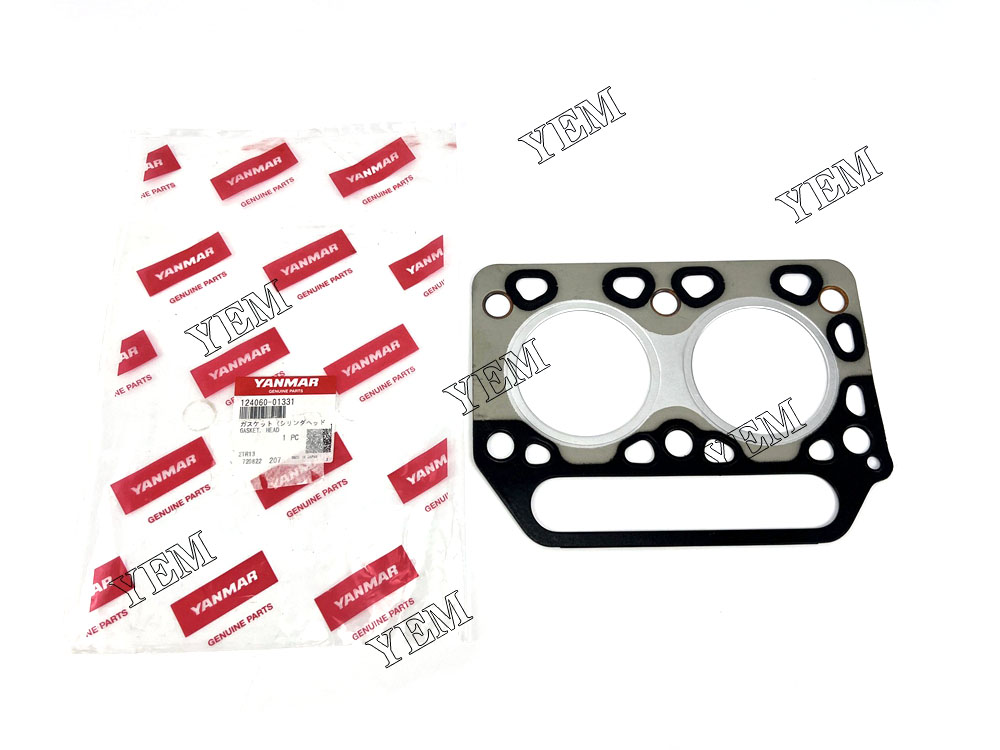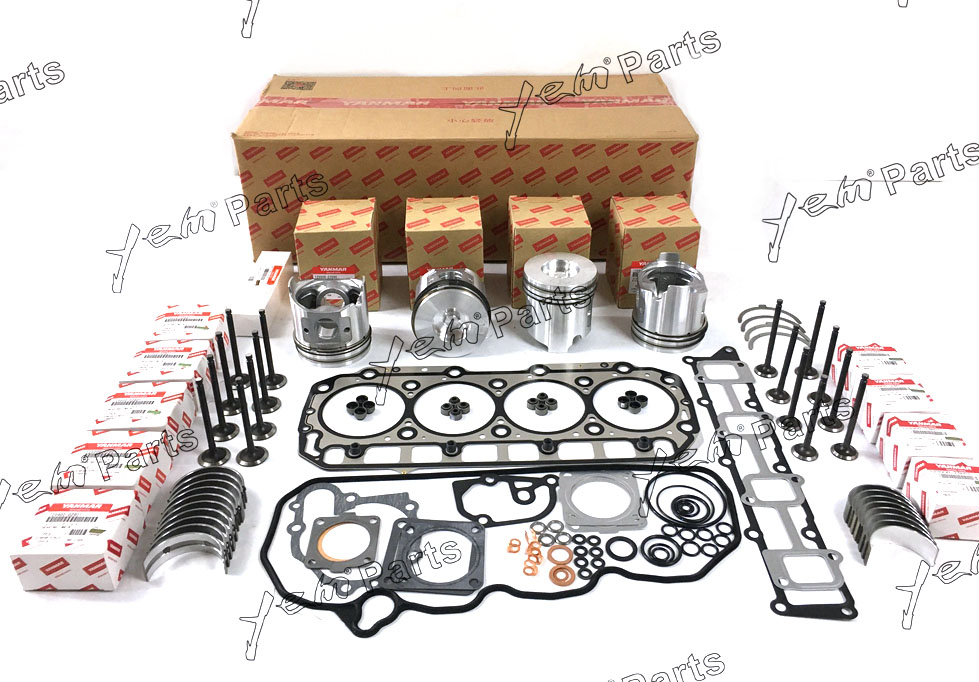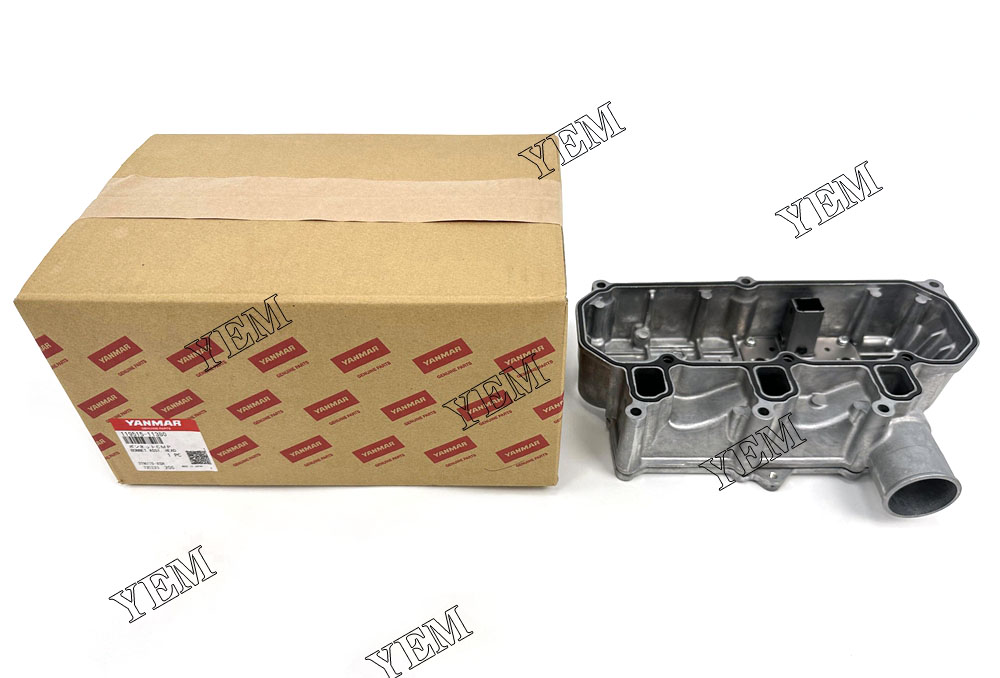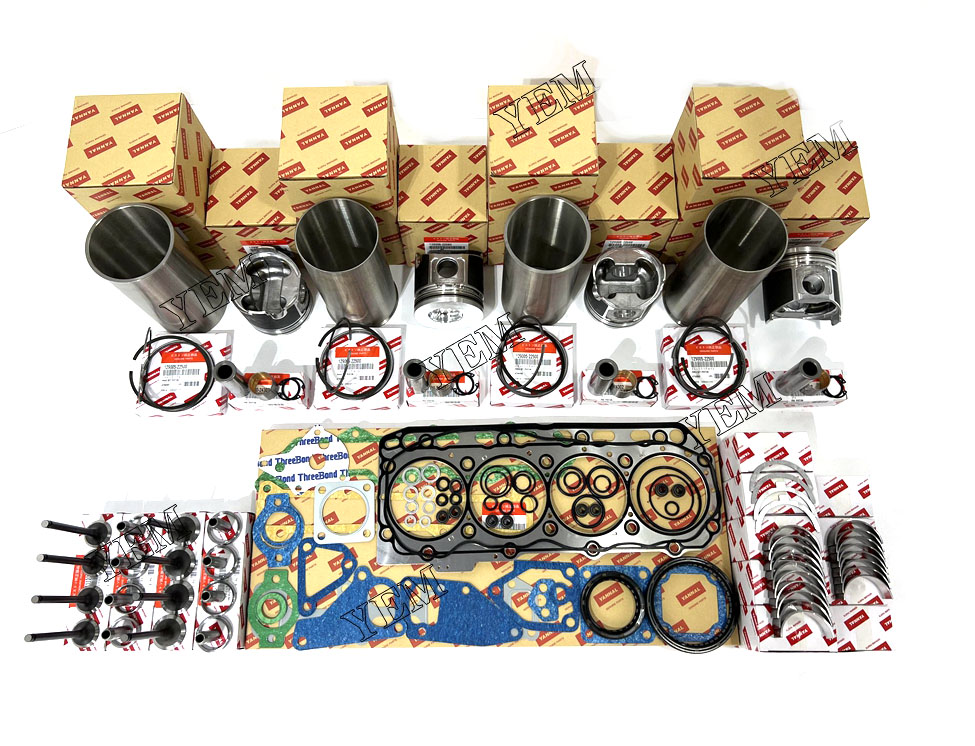Introduction to Yanmar engine parts
Yanmar engine parts refer to various parts used to assemble and repair Yanmar engines. Yanmar engine accessories have a wide range of types, including but not limited to the following aspects:
- Piston and piston rings: The piston is one of the key components of the engine. It is responsible for moving up and down in the cylinder to generate compression and explosive force. The piston ring plays the role of sealing the cylinder.
- Cylinder liner and crankshaft: The cylinder liner is the protective layer of the cylinder wall, and the crankshaft converts the up and down motion of the piston into rotational power.
- Intake and exhaust system parts: including intake manifold, intake valve, valve apron, exhaust valve, etc. These parts participate in the engine’s air flow control and the process of entering and exiting the cylinder.
- Ignition system parts: including spark plugs, spark plug coils, ignition coils, etc., used to provide ignition energy to ignite the fuel mixture.
- Fuel system parts: fuel pump, fuel injector, fuel tank filter, etc., used to provide and inject fuel into the cylinder.
- Alternator and starter: The alternator is responsible for charging the battery, and the starter is responsible for starting the engine.
- Cooling system parts: including radiator, water pump, temperature sensor, etc., used to maintain the engine’s operating temperature within the appropriate range.
- Lubrication system parts: including oil pump, oil filter, oil pan, etc., used to ensure the lubrication and cooling of various engine components.

These are just some of the Yanmar engine accessories, and they will vary depending on the engine model and purpose. Choosing the right Yanmar engine parts is important to your engine’s performance, reliability, and longevity. It is recommended that when purchasing and replacing engine accessories, you choose high-quality original or reliable brand products, and determine the appropriate accessories according to the specific car model and needs.
Engine troubles and diagnostics
Engine failure is one of the common problems during car use. Here are some common engine problems and how to diagnose them:
- The engine is difficult to start or cannot be started:
- Possible reasons: low battery power, ignition system failure, fuel supply problem, etc.
- Diagnostic methods: Check battery status, check spark plugs and ignition coils, check whether the fuel pump and injectors are working properly.
- The engine loses power or accelerates slowly:
- Possible causes: ignition system failure, fuel supply problem, insufficient cylinder compression, etc.
- Diagnostic methods: Check the spark plugs and ignition coils of the ignition system, check the filters and injectors of the fuel system, and perform a compression test to check cylinder compression.
- The engine emits black smoke or has abnormal emissions:
- Possible causes: fuel supply problem, ignition system failure, uneven cylinder pressure, etc.
- Diagnosis method: Check whether the fuel injector of the fuel system is clogged or the fuel injection amount is abnormal, check the spark plug and ignition coil of the ignition system, and check whether the cylinder pressure is uniform.
- Abnormal noise or vibration in the engine:
- Possible causes: piston knocking, crankshaft bearing wear, valve system failure, etc.
- Diagnosis method: Check whether the piston and piston ring are worn, check whether the crankshaft bearing and connecting rod bearing are damaged, and check whether the valves of the gas distribution system are adjusted correctly.
- Engine overheating:
- Possible reasons: cooling system failure, water pump failure, radiator blockage, etc.
- Diagnosis method: Check the coolant level and quality, check the working status of the water pump, and check whether the radiator is blocked.
- Engine oil leakage:
- Possible causes: damaged seals, damaged oil pan, failure of the lubrication system, etc.
- Diagnosis method: Check whether the seals in various parts of the engine are intact, check whether the oil pan and oil filter are damaged, and check the working status of the lubrication system.

The above only lists several common engine faults and corresponding diagnostic methods. Specific diagnosis and solution methods need to be judged and processed based on the actual situation and professional technology. When an engine failure is discovered, it is recommended to go to a professional car repair technician for inspection and repair as soon as possible to ensure safety and normal engine performance.
Yanmar engine maintenance
Proper maintenance is crucial to ensure the optimal performance and longevity of Yanmar engines. Here are some key maintenance tips for Yanmar engines:
- Regular Oil Changes: Change the engine oil at recommended intervals using the correct oil grade specified by Yanmar. This helps to maintain proper lubrication and prolong the engine’s life.
- Fuel Filter Replacement: Replace the fuel filter as per the manufacturer’s instructions to ensure clean fuel reaches the engine and prevent clogging or damage.
- Air Filter Cleaning/Replacement: Clean or replace the air filter regularly to prevent dust and debris from entering the engine and causing damage or reduced performance.
- Cooling System Maintenance: Check the coolant level, condition, and quality regularly. Flush and replace the coolant as recommended by Yanmar to prevent overheating and corrosion.
- Belt Inspection and Replacement: Inspect the engine belts for signs of wear or damage. Replace the belts if they are cracked, frayed, or loose to prevent failures and ensure proper engine operation.
- Regular Battery Check: Check the battery terminals for corrosion and ensure a secure connection. Test the battery voltage and recharge or replace it if necessary.
- Inspect Hoses and Connections: Regularly inspect all hoses, clamps, and connections for leaks, wear, or damage. Replace any damaged components to prevent coolant or fuel leaks.
- Maintenance of Seawater/Cooling System: For marine applications, ensure proper maintenance of the seawater pump, heat exchanger, and other cooling system components as specified by Yanmar.
- Regular Inspection of Gaskets and Seals: Check for any signs of leakage or deterioration in gaskets and seals. Replace them as needed to maintain proper sealing and prevent fluid leaks.
- Follow Yanmar’s Maintenance Schedule: Yanmar provides specific maintenance schedules in the engine’s manual. Follow these guidelines for routine inspections, services, and replacements to keep your engine in optimal condition.
Remember to always refer to the engine’s manual and follow Yanmar’s recommendations for maintenance procedures and intervals. If you are unsure or need assistance, consult a qualified Yanmar service technician or dealer.

Improved engine performance
To improve engine performance, there are several steps you can take:
- Regular Maintenance: Follow a regular maintenance schedule as recommended by the engine manufacturer. This includes oil changes, filter replacements, and inspections of various components.
- Use the Right Fuel: Make sure you are using the correct type and quality of fuel recommended by the engine manufacturer. Using fuel with the proper octane rating and avoiding old or contaminated fuel can optimize engine performance.
- Clean Air Intake System: Ensure the air intake system, including the air filter and intake manifold, is clean and free from debris. A clogged air intake can restrict airflow to the engine, reducing performance.
- Spark Plug Maintenance: Inspect and clean or replace spark plugs as needed. Worn or dirty spark plugs can cause misfires, reduced power, and decreased fuel efficiency.
- Fuel Injector Cleaning: Over time, fuel injectors can become clogged or dirty, affecting fuel delivery and engine performance. Consider using a fuel system cleaner or having the injectors professionally cleaned.
- Check and Adjust Timing: Incorrect ignition timing can lead to poor engine performance. Regularly check and adjust the ignition timing according to the manufacturer’s specifications.
- Engine Tuning: If you have the technical knowledge, you may consider tuning the engine for improved performance by adjusting parameters such as air-fuel mixture, ignition timing, and fuel maps. However, it is important to be careful and consult professionals or refer to the engine manufacturer’s guidelines to prevent potential damage.
- Upgrade Components: Certain engine components such as air filters, exhaust systems, and fuel systems can be upgraded to improve performance. Research and consult with experts to determine appropriate upgrades for your specific engine.
- Monitor and Reduce Engine Load: Avoid excessive load on the engine by monitoring and controlling factors such as overloading, revving the engine excessively, and excessive idling. Operating the engine within recommended limits can improve performance and prolong its lifespan.
- Consider Professional Assistance: If you’re not confident in performing engine upgrades or advanced tuning yourself, consider consulting a professional tuner or mechanic who specializes in engine performance enhancements.
Remember, before making any significant modifications to your engine or performing maintenance procedures beyond your expertise, it’s important to consult with professionals or refer to the engine manufacturer’s recommendations to ensure the modifications are safe and align with warranty requirements.
Yanmar Engine Parts Selection Guide
As an AI assistant, I can provide general information about Yanmar engine parts selection. When selecting Yanmar engine parts, it’s important to consider the following factors:
- Engine Model: Identify the specific model of your Yanmar engine. This information is usually available in the engine’s documentation or on the engine itself.
- Part Number: If you already know the part number of the specific part you need, it will make the selection process easier. Yanmar engine parts usually have unique part numbers for identification.
- Authorized Dealer: It is advisable to purchase Yanmar engine parts from authorized dealers or distributors. They can provide genuine parts and often have knowledgeable staff who can help you select the correct parts for your engine model.
- Compatibility: Ensure that the parts you select are compatible with your Yanmar engine model. Some parts may be universal, while others may be specific to certain engine models or configurations.
- Quality: Consider the quality of the parts you are purchasing. Genuine Yanmar parts are recommended as they are designed specifically for Yanmar engines and are more likely to offer better fit and performance.
- Price and Warranty: Compare prices from different sources to ensure you are getting a fair deal. Additionally, check the warranty provided with the parts to ensure you have sufficient coverage in case of any issues.
It’s always a good idea to consult the Yanmar engine’s documentation or reach out to authorized dealers or Yanmar customer support for specific guidance related to your engine model and parts selection.

Compare different brands of Yanmar engine parts
For the comparison of Yanmar engine accessories, we need to understand the situation of different brands. Here are some common Yanmar engine parts brands, along with their features and benefits:
- Yanmar Genuine Parts:
- Genuine accessories produced by Yanmar original factory, ensuring perfect match with Yanmar engine.
- Provide high quality, reliability and performance guarantee.
- Usually have a long warranty and are protected by official support and after-sales service.
- OEM brand accessories:
- OEM (Original Equipment Manufacturer) brand parts are produced by other companies, but are the same original parts that come with Yanmar engines.
- These brands are usually produced by authorized manufacturers and are comparable in quality to genuine Yanmar accessories.
- The price is relatively low and suitable for some consumers’ budget needs.
- Third-party market accessories:
- These accessories are often provided by unofficial manufacturers and their quality and performance may vary depending on the manufacturer.
- Third-party market accessories are generally cheaper, but come with certain risks in terms of quality and reliability.
- If you decide to purchase third-party market accessories, it is recommended to choose a reputable and verified supplier and pay attention to the instructions for use and warranty policy.
When purchasing Yanmar engine parts, it is recommended to give priority to genuine Yanmar original parts or authorized OEM brand parts. This ensures high quality, reliable performance, and official support and after-sales service. If your budget is limited, you can also consider some proven third-party market accessories, but be aware of the quality and reliability risks.
Contact us
Dear valued customers
We are excited to introduce our professional excavator parts team at YEM! As a dedicated group of experts, we specialize in providing high-quality and reliable excavator parts for all your construction needs. With years of experience in the industry, we have established ourselves as a trusted supplier of top-notch components for various excavator models.
Our team consists of skilled technicians, engineers, and customer service professionals who are committed to delivering exceptional service and ensuring customer satisfaction. We understand the importance of having reliable equipment on the job site, and that’s why we strive to offer a comprehensive range of excavator parts that meet the highest standards of quality and performance.
Whether you need replacement parts for routine maintenance or emergency repairs, our team is here to assist you. We work closely with leading manufacturers and suppliers to source genuine and OEM (Original Equipment Manufacturer) parts, ensuring compatibility and durability. From hydraulic cylinders and pumps to undercarriage components and attachments, we have a wide selection of excavator parts to cater to your specific requirements.
What sets us apart is our attention to detail and commitment to excellence. Our team conducts thorough inspections and quality checks on all parts to ensure they meet stringent industry standards. We also provide expert guidance and technical support to help you choose the right parts for your excavator model and application.
At our company, we prioritize customer satisfaction above all else. We strive to offer competitive pricing, prompt delivery, and excellent after-sales service. Our knowledgeable customer service representatives are available to answer any queries you may have and provide assistance throughout the purchasing process.
When it comes to excavator parts, trust our professional team to deliver the reliability and performance you need. Contact us today to discuss your requirements and experie
